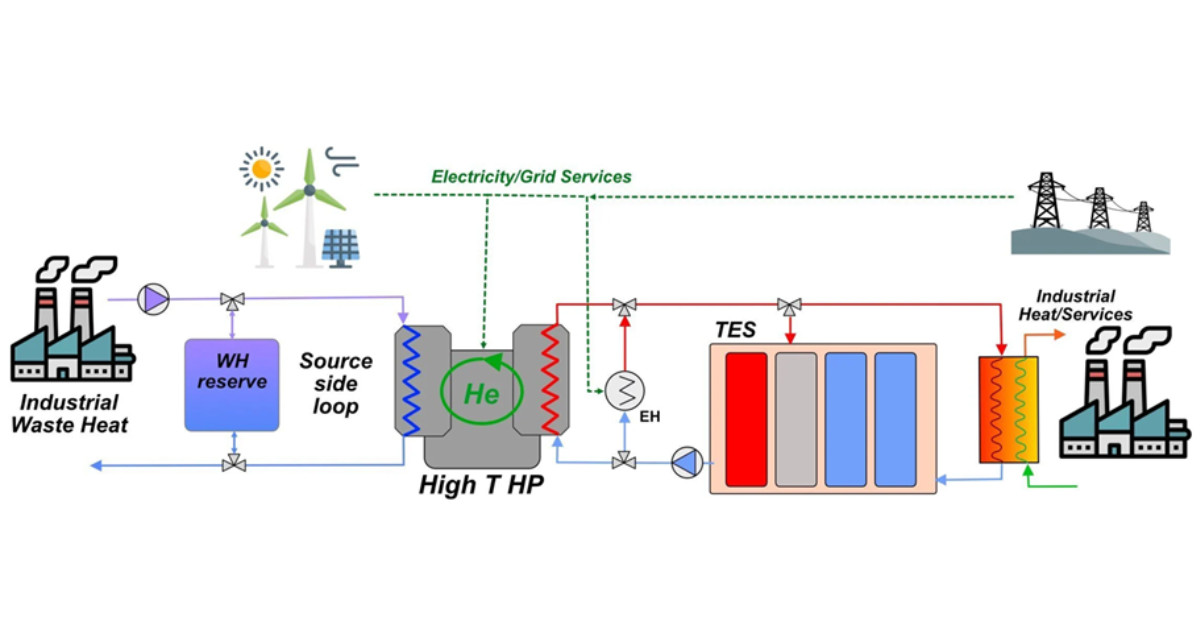Oslo, 10 March, 2025 — The €2 million Horizon Europe I-UPS project was launched in May 2024 to develop a First-of-a-Kind (FOAK) high-temperature industrial hybrid heat pump integrating thermal energy storage solutions. The proposed system aims to store thermal energy at around 400°C and provide heat up to 400°C, targeting a wide market sector requiring saturated steam in the range of 180-200°C.
A techno-economic feasibility of the hybrid FOAK system has been published by I-UPS authors in the American Society of Mechanical Engineers (ASME) Journal of Engineering for Gas Turbines and Power. The published paper titled the Techno-Economic Comparative Assessment of High-Temperature Heat Pump Architectures for Industrial Pumped Thermal Energy Storage is the first of a planned series of research papers due to be published as part of the joint collaboration.
The preliminary research results indicate that combining the heat pump, direct electric heater and molten salt solutions can achieve a lower cost of heat and greater CO₂ abatement compared to competing alternatives — despite associated CAPEX requirements and the remaining technological integration uncertainties.
Horizon Research and Innovation Action I-UPS project integrates an existing high-temperature heat pump (HTHP) technology from Norway’s Enerin AS and a modular-tank molten salt (MS) based thermal energy storage system from Kyoto Group AS for flexible heat generation.
The proposed I-UPS solution and test rigs aim to break ground in generating renewable industrial steam on demand, in the range of 150°C and 400°C, offering an alternative to non-flexible electric and gas-driven boilers. Typical target sectors are industrial users of steam, such as the paper and cardboard industries, chemical and pharmaceutical sectors, and food sector industries that pasteurize, distill, bake, cook, and dry products.
“The investigated system includes a Stirling cycle based HTHP which permits to upgrade waste heat stream from a source side in the range 20–120 °C to a sink side up to 400 °C, an inline electric heater (EH), a molten salt (ternary salt with a mass ratio of 43% potassium-nitrate (KNO3), 15% sodium-nitrate (NaNO3), and 42% calcium nitrate (Ca(NO3)2), [12]) based modular TES, and a MS (molten salt) based steam generator,” the paper explains.
The ASME journal research paper reports that over 80% of the current industrial demand for saturated or superheated steam in the low and medium temperature range, between 150°C and 400°C, is fuelled by fossil fuel sources. The authors indicate that while there are existing solutions for de-linking industries from fossil fuels, the initial investments often pose significant hurdles for a quick market adoption.
The lead author and Scientific Co-ordinator of I-UPS at the KTH Royal Institute of Technology, Department of Energy Technology, Division of Heat and Power, Assistant Professor Silvia Trevisan, said that the initial assessment of the proposed renewable system can be cost-competitive, particularly for industry that has a process thermal energy demand of around 10 megawatts (MWs), and waste heat temperatures above 80°C.
“The system would contribute significantly to industrial electrification, also lowering its burden on the electrical grid and its stability, and it would significantly lower CO2 emissions in the industrial sector,” she said.
The key research results, below, factored in the industrial thermal load profiles, electricity prices and penalties, CO2 taxes, the HTHP capital costs (CAPEX), and HTHP real to Carnot efficiency ratio, amongst others.
-
The proposed system could deliver up to more than a 30% reduction in the overall electricity consumption with respect to electric boilers.
-
The system would be cost-competitive compared to non-flexible electric boilers. Levelized cost of heat savings of 15%, and higher, could be achieved for industry with continuous thermal demand.
-
Higher savings can be attained in the case of higher electricity prices (around 75–100 €/MWh), even in small scale installations (with a thermal load lower than 1 MW).
-
Capital investment reductions or improvements of the thermodynamic performance of the HTHP can lead to larger levelized cost of heat savings of about 15–20% against nonflexible electric boiler based systems.
-
The maximum sink side temperatures for the HTHP is between 300°C and 350°C. This limits the role of the HTHP to MS preheating, requiring a EH to further boost the MS temperature, to maximize the system performance.
The authors of the paper are Silvia Trevisan and Rafael Guedez (KTH Royal Institute of Technology), Bjarke Buchbjerg (Kyoto Group AS), Arne Høeg (Enerin AS). Further work will expand on this comparative assessment to include more detailed modelling of different components and their cost estimations.
Other consortium members in I-UPS include the Thermochemical Power Group from the University of Genovà, and a leading Spanish thermal energy storage company RPow.
Co-ordinator: Communication:
Silvia Trevisan (trevisan@kth.se) Kyoto Group AS (james.brown@kyotogroup.no)
KTH Royal Institute of Technology Enerin AS (philippa@enerin.no)
Department of Energy Technology,
Division of Heat and Power Technology
